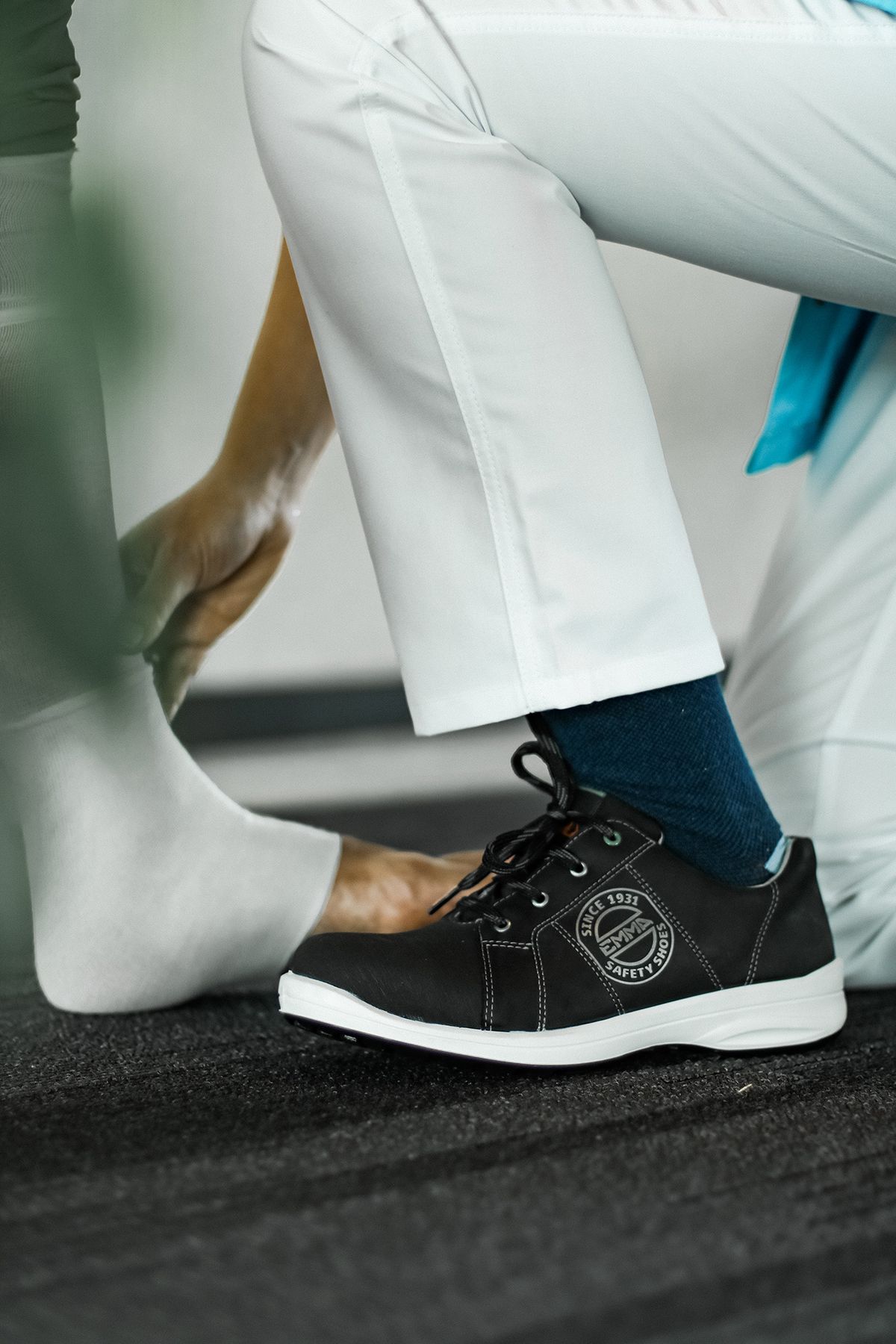Safest foot protection based on socially responsible production, with a focus on a circular supply cycle
Awards2022 SDG Pioneer in Supply Chain Sustainability
Iris van Wanrooij
Program Manager Corporate Social Responsibility
EMMA Safety Footwear
Netherlands
When Iris van Wanrooij was studying fashion at King’s College London in 2010, she was shocked to learn that the production of one pair of jeans used 7,000 liters of water.
That discovery sparked her interest in sustainability, and today she is Program Manager Corporate Social Responsibility at EMMA Safety Footwear.
“This was such an eye-opener for me,” she told the UN Global Compact. “This was the start of my sustainability journey.”
Van Wanrooij heads up the “EMMA’s Positive Footprint” program at the Dutch company, working with department leads to improve worker conditions in the supply chain, marketing to communicate sustainability efforts and product development to make use of durable materials, recycled and sustainable content and materials.
She also educates colleagues on sustainability, creates awareness among suppliers and directs sustainable development processes from company strategy to new shoe linings. The Dutch company makes safety shoes and boots for use in an array of industries.
“Our supply chain is fragmented and we have suppliers in risk countries,” she said. “Even though a large part of the production is still done in our own factory in The Netherlands, it is important to keep a close watch on what is happening in our supply chain.”
Van Wanrooij was selected the 2022 SDG Pioneer in Supply Chain Sustainability by the UN Global Compact. The annual SDG Pioneers programme honors company professionals who are using business to advance and advocate for the 17 Sustainable Development Goals.
“It’s a great honor,” she said. “It shows that I am on the right track regarding our work on the SDGs.
“At the same time, it is also a motivation for me to do even better,” she said. “Being a SDG Pioneer is an opportunity for me to network with peers and to learn from each other in how to accelerate our work towards reaching the Global Goals by 2030. It enables me to spread our story and to further empower our impact.”
She has helped define benchmarks that are most relevant to EMMA - using 100% sustainable material inputs that are renewable, recyclable or reusable, reducing science-based emissions in line with a 1.5°C pathway and 100% resource recovery, with all materials and products recovered and recycled or reused at end of use. Some 6450 solar panels are in use at EMMA’s site.
All of EMMA’s shoes have linings with 76% recycled polyester, insoles with 48% recycled polyester and inlay soles with 85% recycled foam. The shoe boxes are made with 100% recycled cardboard and the laces are made from recycled material as well.
After a determination that the majority of EMMA’s environmental impact is caused by the production of polyurethane, steel and leather, all of the polyurethane waste from its own production facility is recycled, and its leather comes from a tannery where the waste water is purified and leather waste is reused into fertilizers.
“Many people often think that only their contribution does not make a significant difference,” van Wanrooij said. “However … every step counts.
“Every company needs to contribute to the SDGs,” she said. “The SDGs are icons to me.”

How have you contributed to your company’s success by setting ambitious SDG targets, scale and impact? Please be as specific as possible and elaborate on measurable outcomes where relevant.
I started with a programme management approach. I lead the overall programme “EMMA’s Positive Footprint”, in which I am working with department leads, such as supply chain (to improve worker conditions), marketing (to communicate our sustainability efforts), product development (to make use of durable materials, materials that meet our safety and sustainable standards, recycled content, etc.). I connected EMMA’s mission, “Safest foot protection based on socially responsible production, with a focus on a circular supply cycle” to three SDGs: 8, 9 and 12, as these were most relevant. These SDGS were connected to “ER” goals (e.g. highER degree of transparency in supply chain, smallER footprint of products). Based on these “ER” goals, I defined projects, with the project leaders. For these projects, I defined activities, tasks and KPIs. An example of such a KPI for the product development team is: “10% recycled or sustainable content on average based on weight, for the full shoe collection of EMMA by June 2022”. This KPI is mostly related to SDG 12. In addition to our “own” KPIs, we have developed KPIs based on standard Global Reporting Initiative Disclosures and related these to the SDGs, with sustainability platform Worldfavor. In Worldfavor, we defined which GRI Disclosures are in our scope, and in Worldfavor we report on our KPIs, to track our progress. For example, EMMA’s KPI 0 accidents in the workplace by 2030 (Scope 1), is based on GRI Disclosure 403-9 Work-related injuries and is connected to SDG targets 3.3, 3.4, 3.9 and SDG 8.8.
Have you led the development of innovative products, services, and/or business models that advance the SDGs? If yes, please be as specific as possible and demonstrate ownership of the process.
The most innovative developments I have been working and pushing on are the recycled and sustainable materials in EMMA’s collection, and the circular efforts in our supply chain. EMMA knows the exact composition of each material and selects suppliers herself. The materials are listed in materials passports. A recent lifecycle assessment we did with Ecochain showed that the majority of our environmental impact is caused by the production of polyurethane, steel and leather. All the polyurethane waste from our own production facility in Kerkrade is recycled into isolation materials. The leather comes from a Leather Working Group Gold tannery, where the waste water is purified. The leather waste is reused into fertilizers. Without comprising on quality or safety, the majority of our shoes contain a lining with 76% recycled polyester, an insole with 48% recycled polyester, an inlay sole with 85% recycled foam, a shoe box with 100% recycled cardboard and laces with recycled PET and/or recycled jeans. The materials still have a long lifespan. Suppliers need to sign a Restricted Substances List. I have been focusing on increasing mono materials and on reducing the components for easy dismantling. EMMA has initiated the Circular Footwear Alliance with a competitor (www.cfalliance), a take-back programme for used footwear. I am in the dismantling and steering committee of CFA. We are currently in piloting stage for the dismantling, together with CHILL (www.chilllabs.nl). Together with the commercial director, I have initiated two ongoing pilots with construction companies, in which we offer Shoes as a Service.
How have you collaborated with the UN Global Compact and/or Local Network to advance the SDGs?
In 2021, I completed the SDG Ambition Programme. In this intensive course, I’ve had the chance to collaborate with representatives from other companies, to discuss targets, SDG benchmarks and practical matters, such as how to address gender equality on board level. I ended with a pitch to our Group, and gave advise to the Group. I learned that the following benchmarks are most relevant to EMMA: 100% sustainable material inputs that are renewable, recyclable or reusable; science-based emissions reduction in line with a 1.5°C pathway; 100% resource recovery, with all materials and products recovered and recycled or reused at end of use. Because we aim to have 100% resource recovery by 2030, it is already necessary to make use of mono materials, less components, to develop next use applications for the materials, to collect volumes for recycling with other brands, etc. Hence, the work we do with the Circular Footwear Alliance, and the changes we make in the designs, are key. 100% sustainable material inputs that are renewable or recyclable go hand in hand with resource recovery. We have a target of a reduction of 5% of CO2 emissions on an annual basis, relative to sales. We calculate and reduce our Scope 1 and 2 emissions and I am now starting with Environmental Product Declarations. We have 6450 solar panels on EMMA’s site and are ISO 14001 certified. In Worldfavor, I report on diversity and our owner has hired an agency to work on Gender Equality with us.
How have you led efforts to integrate the UN Global Compact Ten Principles into your business strategies and functions? What was your specific role?
In 2019, I took the initiative to join the Dutch Agreement on Sustainable Textiles, as the first and only shoe brand. I felt I needed support in our due diligence process, as our supply chain is fragmented and we have suppliers in risk countries. Even though, a large part of the production is still done in our own factory in The Netherlands, it is important to keep a close watch on what is happening in our supply chain. We have passed every audit from the Sociaal Economische Raad until it ended in December 2021. I have been the main contact for this agreement and therefore have done most of the requested work, with help from the supply chain manager. I also have been part of the creation of the Group Code of Conduct, in which the Ten Principles are included. I made the initiative to make this Code of Conduct Two Way, with an Annex, so suppliers also know what to expect from us as buyers (e.g. a responsible exit strategy and fair lead times). All EMMA employees (white collar workers) needed to sign the Code of Conduct, and answer questions on the Code of Conduct, which includes a special Anti-Corruption module that has been drafted by our owner Latour. I make use of Worldfavor to collect the questionnaires from our suppliers and evaluate the risk scores, based on country level and the answers they gave in our Self-Assessment Questionnaire (where they can also upload audit reports and other documents).
How have you been instrumental in identifying new ways to engage on the sustainable development agenda? How have you engaged, mobilized, inspired, and rallied colleagues and external stakeholders to support the SDGs?
I have the lead in writing the yearly sustainability report for EMMA, which includes the SDGs. Today, I also coordinate the sustainability report for Hultafors Group, EMMA’s mother company. I have spent much effort on educating and inspiring colleagues and other stakeholders through network meetings, presentations and meetings. EMMA has been part of the first social enterprise of the Netherlands, so social entrepreneurship has been in our DNA since 1931. We still have 63% of people with a distance to the labour market, so our messages needed to be tailored to this audience through visuals. In the past year, I have participated in the Leadership Team and Management Team, to put sustainability on the agenda. Consulting various stakeholders is important to me, so that I get different perspectives and therefore know more specifically where we have to steer. In addition, I regularly accompany account managers to tell them about EMMA's sustainable journey, because we notice that customers like to know where their products come from and how they too can contribute to the Sustainable Development Goals. I play an important role in creating awareness among suppliers and in retrieving the right data. I direct every sustainable development process, from sustainability strategy to a new lining for the shoes, and create internal ambassadors. This way I get people involved in an organic way. I do this, among other things, by having conversations with staff members, by involving people early, creating ownership and by taking them with me in an inspiration session.
Photo credit: Rabobank and EMMA Safety Footwear



.jpg?1656565169355)





